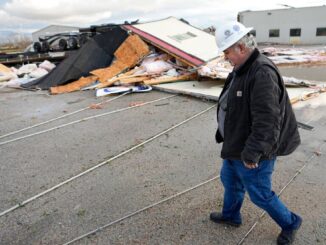
ENB Pub Note: Ed Ireland is an industry thought leader, and I highly recommend subscribing to his substack listed at the bottom of the article.
The Texas electricity grid is famous because it is not interconnected with neighboring power grids. The story behind that goes back to 1935 when President Franklin D. Roosevelt’s New Deal created the Federal Power Commission, with the power to regulate interstate commerce in electricity. Texas electricity generators decided they didn’t want to be controlled by the feds, so they agreed never to sell or buy electricity across state lines. Texas chose not to connect with neighboring power grids to avoid federal regulation. That choice was made decades before Texas became the largest producer of natural gas and crude oil in the U.S., giving the state ample natural gas supplies that didn’t have to be transported on federally regulated interstate pipelines.
While the Texas power grid was free of federal regulations, it was managed as a regulated electricity market similar to all other U.S. grids, meaning that utilities owned and operated all aspects of electricity. The groundwork to open electricity markets was laid when the U.S. Congress passed the Energy Policy Act in 1992, which started to open the electricity market.
Texas was the first state to deregulate its wholesale electricity market in 1995 and then got into a race with California to deregulate its retail electricity market. California won and deregulated its retail electricity market in 1996, three years ahead of Texas deregulating all aspects of the electricity market in 1999. Senate Bill 7 unbundled each of the three stages of electricity: generation, transmission, and retail sellers.
The reason for the three-year delay in Texas was that deregulation became a boiling political potato. There was plenty of disagreement and politics surrounding the deregulation of the power markets. Big utilities didn’t like it because they feared losing control of their systems, and consumer groups feared it would raise their rates. Environmentalists feared that wind and solar would be squeezed out.
A few Texas Representatives worked with municipally-owned utilities and promised them exemptions from the deregulation bill. Energy traders were brought on board because they were guaranteed profits under the new system. Retail consumers were assured that electricity prices would decline due to competition. They would have the Power to Choose their electricity provider. The politicians assured environmental groups that the new deregulated market would spur innovation and clean energy like wind and solar. Sure enough, electricity prices declined, and Texans paid 28% less per kilowatt hour than the average American in 2019.
With the arrival of Winter Storm Uri in 2021, the Texas power grid became famous, or some would say infamous when it was 4 minutes and 37 seconds from complete collapse. That near failure was the beginning of a string of tight near blackouts and market uncertainties in December 2022, followed by a series of tight grid conditions at 8 PM during the summer of 2023, when the sunset and peak demand.
Winter Storm Elliott followed Uri in December 2022; the consequences were not as severe as Uri’s but highlighted the problems that had crept into the ERCOT grid. The growing amount of wind and solar generation was causing severe reliability issues. The critical problem with the ERCOT system, which is the same problem that all U.S. power grids are experiencing and trying to manage, is intermittent wind and solar power. As the adage goes, the wind doesn’t always blow, and the sun doesn’t always shine. These problems were on vivid display in the summer of 2023 when, night after night, when the sun would set at about 8 PM and solar power dropped to zero, the hot summer wind died as well.
Natural gas-fired generation has usually taken up the slack, but natural gas generation in Texas has been slowly declining due to squeezed profit margins. The grid reliability problems result from the fact that wind and solar can underbid natural gas-fired generation due to their federal subsidies, reducing the daily demand for base-load natural gas generation. While natural gas secures some portion of the base load, additional natural gas generation is expected to be available when wind and solar fail. Over time, this preferential treatment of wind and solar at the expense of natural gas has slowly atrophied the availability of natural gas-fired generation.
To deal with the problems facing the Texas power grid, State legislators passed a bill in the recent legislative session that ended May 31, 2023, that creates the Texas Energy Fund, which is designed to “support the creation of new and robust energy infrastructure.” A flyer mailed to Texas voters said the Texas Energy Fund will lead to a larger supply of electricity when Texans need it and will:
- Modernize and weatherize electric generation facilities so that they are more resilient and continue to operate despite extreme weather, and
- Protect Texans from increases to their electricity bills by reducing expensive shortage events.
The state fund will also provide loans and grants to companies to build new natural gas-fired power plants. This would include providing 3% interest rate loans for the construction and upgrades to gas-fired power plants connected to ERCOT’s main electric grid and would pay a bonus if the new plants are up and running by June 2029. The Legislature set aside $5 billion to fund these programs for the next two years.
Proposition 7 is on the ballot for the November 7 election, says:
The constitutional amendment providing for the creation of the Texas energy fund to support the construction, maintenance, modernization, and operation of electric generating facilities.
The debates have begun with many attacks claiming that natural gas generation is causing climate change. The Texas Tribune said: “Gas-fueled power plants are not always reliable and emit greenhouse gasses, which are driving climate change.”
My Take: The addition of weather-dependent power generation, wind and solar, has provided a new set of challenges to ERCOT and other U.S. power grids because they are not dispatchable power. Texas has flexibility that other power grids do not have because ERCOT is not subject to FERC oversight. The Public Utility Commission of Texas is working with the State of Texas lawmakers to enact innovative programs at the state level. Other U.S. power grids are facing the same problems and are coming up with creative ways to deal with them. For example, JPM recently asked FERC for permission to revise capacity auction rules, which FERC approved.
As wind and solar continue to increase as federal subsidies flow out of the misnamed Inflation Reduction Act, U.S. power grids will continue to be destabilized and will be forced to find innovative ways to stabilize power grids. Texas has more flexibility since it is not subject to FERC oversight, but the challenges facing all power grids will continue to pose challenges to keep the lights on.
As Robert Bryce says, “If we are serious about addressing climate change and making our energy and power systems more resilient, the last thing we should be doing is making our most important energy network — the electric grid — dependent on the weather.”
U.S. power grids will continue to have problems with stability and reliability as long as federal subsidies for wind and solar continue. Hopefully, the Texas plan to attract the construction of new natural gas-fired generation will be successful.
Thank you for reading “Thoughts about Energy and Economics.” This is a reader-supported publication, so please “Like” it, share it with friends and colleagues, and become a paid subscriber. Your support is greatly appreciated! – Follow Ed Ireland HERE:



